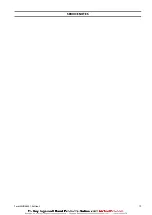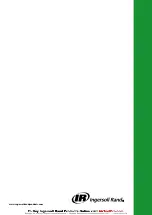
MAINTENANCE
WARNING
•
Never perform maintenance on the winch while it is supporting a load.
•
Before performing maintenance, tag controls:
WARNING - DO NOT OPERATE, EQUIPMENT BEING REPAIRED.
•
Only allow Ingersoll Rand trained Technicians to perform maintenance on
this winch.
•
Shut off air system and depressurize air lines before performing any
maintenance.
•
Do not use Trichloroethylene to clean parts.
•
Use of other than genuine Ingersoll Rand parts may result in safety hazards,
decreased performance and increased maintenance and will invalidate all
warranties.
•
After performing any maintenance on the winch, test winch to 125% of its
rated line pull at mid drum before returning to service. (Testing to more
than 125% of rated line pull may be required to comply with standards and
regulations set forth in areas outside the USA.)
NOTICE
•
Some options are not available for a Man Rider winch, refer to data (name)
plate.
n
General
Correct disassembly (to prevent loss or damage of good parts), repair, assembly,
testing and adjusting are critical to proper winch operation. Maintenance
procedures are technical in nature and require training and experience to
accomplish correctly. In addition, repair and testing require specialized equipment
that is not typically found at the products mounting site.
Proper use, inspections and maintenance increase the life and usefulness of your
Ingersoll Rand equipment. During assembly, lubricate gears, nuts, capscrews and
all machined threads with applicable lubricants. Use of anti-seize compound and/
or thread lubricant on capscrew and nut threaded areas prevents corrosion and
allows for easy disassembly of components.
It is extremely important that anyone involved with maintaining the product be
familiar with the servicing procedures of these products and be physically capable
of conducting the procedures. These personnel shall have skills that include:
1. Proper and safe use and application of mechanics’ common hand tools as well
as special Ingersoll Rand or recommended tools.
2. Safety procedures, precautions and work habits established by accepted
industry standards.
Ingersoll Rand cannot know of or provide all the procedures by which product
operations or repairs may be conducted and the hazards and/or results of each
method. If operation or maintenance procedures not specifically recommended by
the manufacturer are conducted, it must be ensured that product safety is not
endangered by the actions taken. If unsure of an operation or maintenance
procedure or step, personnel should place the product in a safe condition and
contact supervisors and/or the factory for technical assistance.
NOTICE
•
Refer to the Product Parts Information Manual for drawings unless
specified elsewhere.
n
Maintenance Intervals
Refer to Table 3 ‘Maintenance Interval Chart’ on page 4 for recommended
maintenance schedule.
n
Adjustments
n
Winch Guard
Refer to Dwg. MHP2946.
Winch guard panels must be adjusted to suit wire rope departure angle. Adjust per
procedures in Product Information Manual.
n
Disc Brake
Refer to Dwg. MHP2944.
Disc brake adjustment is not required. If disc brake does not hold rated load
disassemble and repair.
If brake assembly is removed or disassembled ensure breather (23) is installed and
located at top of brake housing during reassembly.
n
Manual Band Brake (optional feature)
Refer to Dwg. MHP0627.
1. Release wire rope tension on drum.
2. Rotate handwheel (104) counterclockwise to release brake bands.
3. Loosen nut (120) and turn adjustment screw (127) to provide 1/16 to 1/8 inch
(1.6 to 3.2 mm) gap between band lug and end of adjustment screw when brake
is applied.
4. When correct gap is obtained, tighten nut (120).
5. Check brake band is partially lifted from drum diameter to reduce drag when
brake is not in use.
CAUTION
•
When any part of brake lining thickness measures 0.062 inch (2 mm) or less,
brake bands (128) must be replaced.
n
Automatic Band Brake (optional feature)
Refer to Dwg. MHP2329.
1. Remove cotter pin (57) at link stud (56).
2. Apply air to brake cylinder (134) and remove pin (58) to disconnect link stud (56)
from brake band (59).
3. Turn link stud (56) clockwise to increase cylinder rod extension. Turn link stud
(56) counterclockwise to decrease cylinder rod extension.
4. Assemble link stud (56) to brake band (59) with pin (58) and cotter pin (57).
Release air to brake cylinder (134).
5. Brake should hold rated load (refer to “INSPECTION” on page 2) when cylinder
(134) is retracted. Brake band should not drag on drum when cylinder us
extended.
6. Install cotter pin (57). Bend ends of cotter pin to secure link stud to brake band
when adjustment is complete.
7. With brake “On” adjust screw (127) to just touch brake band (59).
n
Pendant Operated Pilot Control Valve
Valve is set at factory. Refer to “Pendant Operated Pilot Control Valve
Assembly”on page 14 for adjustment procedure.
n
Overload Valve
Refer to Dwg. MHP2619 in Product Information Manual. A. Emergency Stop Button;
B. Push Down to Stop Winch Movement; C. Overload Valve Reset Button; D. Twist
Red Button to Reset; E. Overload Valve Adjustment Screw.
A 5/16 inch or 8 mm open-ended wrench is required.
Adjust overload valve by turning adjustment screw located at bottom of control
valve.
-
Rotating adjustment screw (
clockwise
) will increase pressure required to
activate overload valve.
WARNING
•
This adjustment can cause overload device to NOT activate before winch's
safety limit is exceeded. This procedure should only be done by Ingersoll
Rand trained Technicians.
-
Rotating adjustment screw (
counterclockwise
) will decrease pressure
required to activate overload valve.
n
Limit Switch
Refer to ‘Limit Switch Adjustment’ procedure in Product Information Manual.
n
Tensioning System
Refer to Dwg. MHP2028.
The regulator is preset at 0 psig (0 bar/0 kPa) and therefore requires adjustment
when winch is installed. To adjust for specific load applications, regulator pressure
may be adjusted to increase or decrease tension setting.
Regulator gauge and regulator are accessible through cover.
WARNING
•
When adjusting regulator, ensure winch control lever is locked in neutral
position and tension selector lever is in the NORMAL position.
•
Winch supply air is NOT shut off during regulator adjustments. To prevent
accidental winch operation, allow only a single person, trained in
operation, safety and maintenance of this product, to conduct regulator
adjustments.
Regulator Adjustment Procedure:
Refer to Dwg. MHP1865 in Product Information Manual.
1. Attach test load of desired weight to load line, or connect load line to scale.
WARNING
•
Ensure load line is connected to load and excessive slack is taken up before
activating auxiliary valve. When activated, auxiliary valve will
automatically engage and winch will operate at full speed to set tension on
load line.
2. Using winch control valve remove all slack from load line.
Form MHD56401 Edition 3
7
Содержание FA10i
Страница 17: ...SERVICE NOTES Form MHD56401 Edition 3 17...
Страница 18: ...SERVICE NOTES 18 Form MHD56401 Edition 3...
Страница 19: ...SERVICE NOTES Form MHD56401 Edition 3 19...
Страница 20: ...R www ingersollrandproducts com...































